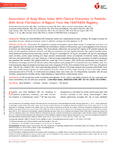Mostrar o rexistro simple do ítem
Association of body mass index with clinical outcomes in patients with atrial fibrillation: a report from the FANTASIIA Registry
| dc.contributor.author | Bertomeu-González, Vicente | |
| dc.contributor.author | Moreno-Arribas, José | |
| dc.contributor.author | Esteve-Pastor, María Asunción | |
| dc.contributor.author | Roldán Rabadán, Inmaculada | |
| dc.contributor.author | Muñiz, Javier | |
| dc.contributor.author | Raña-Míguez, Paula | |
| dc.contributor.author | Ruiz Ortiz, Martín | |
| dc.contributor.author | Cequier, Ángel | |
| dc.contributor.author | Bertomeu-Martínez, Vicente | |
| dc.contributor.author | Badimón, Lina | |
| dc.contributor.author | Anguita, Manuel | |
| dc.contributor.author | Lip, Gregory | |
| dc.contributor.author | Marín, Francisco | |
| dc.date.accessioned | 2020-01-15T09:34:27Z | |
| dc.date.available | 2020-01-15T09:34:27Z | |
| dc.date.issued | 2019-12-24 | |
| dc.identifier.citation | Bertomeu-Gonzalez V, Moreno-Arribas J, Esteve-Pastor MA, Roldán-Rabadán I, Muñiz J, Raña-Míguez P, Ruiz-Ortiz M, Cequier Á, Bertomeu-Martínez V, Badimón L, Anguita M, Lip GYH, Marín F; FANTASIIA Study Investigators. Association of Body Mass Index With Clinical Outcomes in Patients With Atrial Fibrillation: A Report From the FANTASIIA Registry. J Am Heart Assoc. 2020 Jan 7;9(1):e013789. | es_ES |
| dc.identifier.issn | 2047-9980 | |
| dc.identifier.uri | http://hdl.handle.net/2183/24647 | |
| dc.description.abstract | [Abstract] Background. Obesity and atrial fibrillation (AF) frequently coexist and independently increase mortality. We sought to assess the association between obesity and adverse events in patients receiving oral anticoagulants for AF. Methods and Results. Consecutive AF outpatients receiving anticoagulant agents (both vitamin K antagonists and direct oral anticoagulants) were recruited into the FANTASIIA (Atrial fibrillation: influence of the level and type of anticoagulation on the incidence of ischemic and hemorrhagic stroke) registry. This observational, multicenter, and prospective registry of AF patients analyzes the quality of anticoagulation, incidence of events, and differences between oral anticoagulant therapies. We analyzed baseline patient characteristics according to body mass index, normal: <25 kg/m2, overweight: 25–30 kg/m2, and obese: ≥30 kg/m2), assessing all‐cause mortality, stroke, major bleeding and major adverse cardiovascular events (a composite of ischemic stroke, myocardial infarction, and total mortality) at 3 years’ follow‐up. In this secondary prespecified substudy, the association of weight on prognosis was evaluated. We recruited 1956 patients (56% men, mean age 73.8±9.4 years): 358 (18.3%) had normal body mass index, 871 (44.5%) were overweight, and 727 (37.2%) were obese. Obese patients were younger (P<0.01) and had more comorbidities. Mean time in the therapeutic range was similar across body mass index categories (P=0.42). After a median follow‐up of 1070 days, 255 patients died (13%), 45 had a stroke (2.3%), 146 a major bleeding episode (7.5%) and 168 a major adverse cardiovascular event (8.6%). Event rates were similar between groups for total mortality (P=0.29), stroke (P=0.90), major bleeding (P=0.31), and major adverse cardiovascular events (P=0.24). On multivariate Cox analysis, body mass index was not independently associated with all‐cause mortality, cardiovascular mortality, stroke, major bleeding, or major adverse cardiovascular events. Conclusions. In this prospective cohort of patients anticoagulated for AF, obesity was highly prevalent and was associated with more comorbidities, but not with poor prognosis. | es_ES |
| dc.description.sponsorship | The FANTASIIA registry was funded by an unconditional grant from Pfizer/Bristol‐Myers‐Squibb and by grants from the Instituto de Salud Carlos III (Madrid)‐FEDER (RD16/11/00420, RD12/0042/0068, RD12/0042/0010, RD12/0042/0069, and RD12/0042/0063). The authors are supported by RD12/0042/0049 (RETICS) from ISCIII and PI13/00513/FEDER from ISCIII. Fundación Séneca (19245/PI/14), Instituto Murciano de Investigación Biosanitaria (IMIB16/AP/01/06). | |
| dc.description.sponsorship | Instituto de Salud Carlos III; RD16/11/00420 | |
| dc.description.sponsorship | info:eu-repo/grantAgreement/MINECO/Acción Estratégica de Salud/RD12%2F0042%2F0068/ES/Enfermedades cardiovasculares | |
| dc.description.sponsorship | info:eu-repo/grantAgreement/MINECO/Acción Estratégica de Salud/RD12%2F0042%2F0010/ES/Enfermedades cardiovasculares | |
| dc.description.sponsorship | info:eu-repo/grantAgreement/MINECO/Acción Estratégica de Salud/RD12%2F0042%2F0069/ES/Enfermedades cardiovasculares | |
| dc.description.sponsorship | info:eu-repo/grantAgreement/MINECO/Acción Estratégica de Salud/RD12%2F0042%2F0063/ES/Enfermedades cardiovasculares | |
| dc.description.sponsorship | info:eu-repo/grantAgreement/MINECO/Acción Estratégica de Salud/RD12%2F0042%2F0049/ES/Enfermedades cardiovasculares | |
| dc.description.sponsorship | info:eu-repo/grantAgreement/MINECO/Programa Estatal de I+D+I Orientada a los Retos de la Sociedad/PI13%2F00513/ES/NUEVOS ANTICOAGULANTES ORALES EN LA FIBRILACIÓN AURICULAR | |
| dc.description.sponsorship | Fundación Séneca; 19245%2FPI%2F14 | |
| dc.description.sponsorship | Instituto Murciano de Investigación Biosanitaria; IMIB16%2FAP%2F01%2F06 | |
| dc.language.iso | eng | es_ES |
| dc.publisher | NLM | es_ES |
| dc.relation.uri | https://doi.org/10.1161/JAHA.119.013789 | es_ES |
| dc.rights | Creative Commons Attribution-NonCommercial-NoDerivs 4.0 International Licence (CC-BY-NC-ND 4.0) | es_ES |
| dc.rights.uri | http://creativecommons.org/licenses/by-nc-nd/4.0/ | * |
| dc.subject | Atrial fibrillation | es_ES |
| dc.subject | Mortality | es_ES |
| dc.subject | Obesity | es_ES |
| dc.subject | Prognosis | es_ES |
| dc.subject | Risk factors | es_ES |
| dc.title | Association of body mass index with clinical outcomes in patients with atrial fibrillation: a report from the FANTASIIA Registry | es_ES |
| dc.type | info:eu-repo/semantics/article | es_ES |
| dc.rights.access | info:eu-repo/semantics/openAccess | es_ES |
| UDC.journalTitle | Journal of the American Heart Association | es_ES |
| UDC.volume | 9 | es_ES |
| UDC.issue | 1 | es_ES |
| UDC.startPage | e013789 | es_ES |
Ficheiros no ítem
Este ítem aparece na(s) seguinte(s) colección(s)
-
INIBIC-ECAPE - Artigos [31]
-
GI- GRINCAR - Artigos [223]






